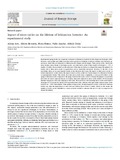Mostrar el registro sencillo del ítem
Impact of micro-cycles on the lifetime of lithium-ion batteries: an experimental study
| dc.creator | Soto Cabria, Adrián | es_ES |
| dc.creator | Berrueta Irigoyen, Alberto | es_ES |
| dc.creator | Mateos Inza, Miren | es_ES |
| dc.creator | Sanchis Gúrpide, Pablo | es_ES |
| dc.creator | Ursúa Rubio, Alfredo | es_ES |
| dc.date.accessioned | 2022-09-15T12:32:06Z | |
| dc.date.available | 2022-09-15T12:32:06Z | |
| dc.date.issued | 2022 | |
| dc.identifier.citation | Soto, A.; Berrueta, A.; Mateos, M.; Sanchis, P.; Ursúa, A.. (2022). Impact of micro-cycles on the lifetime of lithium-ion batteries: An experimental study. Journal of Energy Storage 55, pp. 105343-105343 . | en |
| dc.identifier.issn | 2352-152X | |
| dc.identifier.uri | https://hdl.handle.net/2454/44003 | |
| dc.description.abstract | Experimental aging studies are commonly conducted on lithium-ion batteries by full charge and discharge cycles. However, such profiles may differ from the actual operation of batteries in electric vehicles and stationary applications, where they are subjected to different partial charges and discharges. These partial cycles, which take place during a main charge or discharge process, are called micro-cycles if their depth of discharge is <2 %. A number of authors have pointed out the relevance of the time resolution to estimate the energy throughput of a battery due to these micro-cycles in applications such as renewable microgrids. However, to the best of our knowledge, there are no experimental studies in the literature that assess the impact of these micro-cycles on battery degradation. In this article, the impact of micro-cycles on the loss of performance of a lithium-ion battery is experimentally studied. The results show that micro-cycles have a negligible, or even positive effect on the aging of lithium-ion cells compared to the aging caused by full cycles. In fact, if charge throughput or equivalent full cycles are used to measure the use of a battery, then cells subjected to micro-cycles exhibit a 50 % extended lifetime compared to cells only subjected to full cycles. More precisely, cells including micro-cycles with depth of discharge of 0.5 % lasted for nearly 3000 equivalent full cycles, whereas cells aged under standard deep cycles lasted for no >1500. Nevertheless, if the number of deep cycles, disregarding micro-cycles, is the unit to measure battery use, then the degradation of cells with and without micro-cycles is similar. Based on this result, the number of cycles can be identified as a more accurate variable to measure the use of a cell, in comparison to charge throughput. | en |
| dc.description.sponsorship | This work is part of the projects PID2019-111262RB-I00, funded by MCIN/AEI/10.13039/501100011033/, STARDUST (774094), funded by European Union¿s Horizon 2020 research and innovation programme, HYBPLANT (0011-1411-2022-000039), funded by Government of Navarre, and a Ph.D. scholarship, funded by Public University of Navarre. Open access funding provided by Universidad Pública de Navarra. | en |
| dc.format.mimetype | application/pdf | en |
| dc.language.iso | eng | en |
| dc.publisher | Elsevier | en |
| dc.relation.ispartof | Journal of Energy Storage, 2022, vol. 55, pp. 105343-105343 | en |
| dc.rights | © 2022 The Authors. This is an open access article under the CC BY license | en |
| dc.rights.uri | http://creativecommons.org/licenses/by/4.0/ | |
| dc.subject | Aging | en |
| dc.subject | Depth of discharge | en |
| dc.subject | Electric vehicle | en |
| dc.subject | Micro-cycle | en |
| dc.subject | Renewable energy | en |
| dc.subject | Lithium-ion | en |
| dc.title | Impact of micro-cycles on the lifetime of lithium-ion batteries: an experimental study | en |
| dc.type | Artículo / Artikulua | es |
| dc.type | info:eu-repo/semantics/article | en |
| dc.date.updated | 2022-09-15T12:29:53Z | |
| dc.contributor.department | Ingeniaritza Elektrikoa, Elektronikoaren eta Telekomunikazio Ingeniaritzaren | eu |
| dc.contributor.department | Institute of Smart Cities - ISC | en |
| dc.contributor.department | Ingeniería Eléctrica, Electrónica y de Comunicación | es_ES |
| dc.rights.accessRights | Acceso abierto / Sarbide irekia | es |
| dc.rights.accessRights | info:eu-repo/semantics/openAccess | en |
| dc.identifier.doi | 10.1016/j.est.2022.105343 | |
| dc.relation.projectID | info:eu-repo/grantAgreement/AEI/Plan Estatal de Investigación Científica y Técnica y de Innovación 2017-2020/PID2019-111262RB-I00/ES/ | en |
| dc.relation.projectID | info:eu-repo/grantAgreement/European Commission/Horizon 2020 Framework Programme/774094 | en |
| dc.relation.publisherversion | https://doi.org/10.1016/j.est.2022.105343 | |
| dc.type.version | Versión publicada / Argitaratu den bertsioa | es |
| dc.type.version | info:eu-repo/semantics/publishedVersion | en |
| dc.contributor.funder | Universidad Pública de Navarra / Nafarroako Unibertsitate Publikoa Gobierno de Navarra / Nafarroako Gobernua | es |



